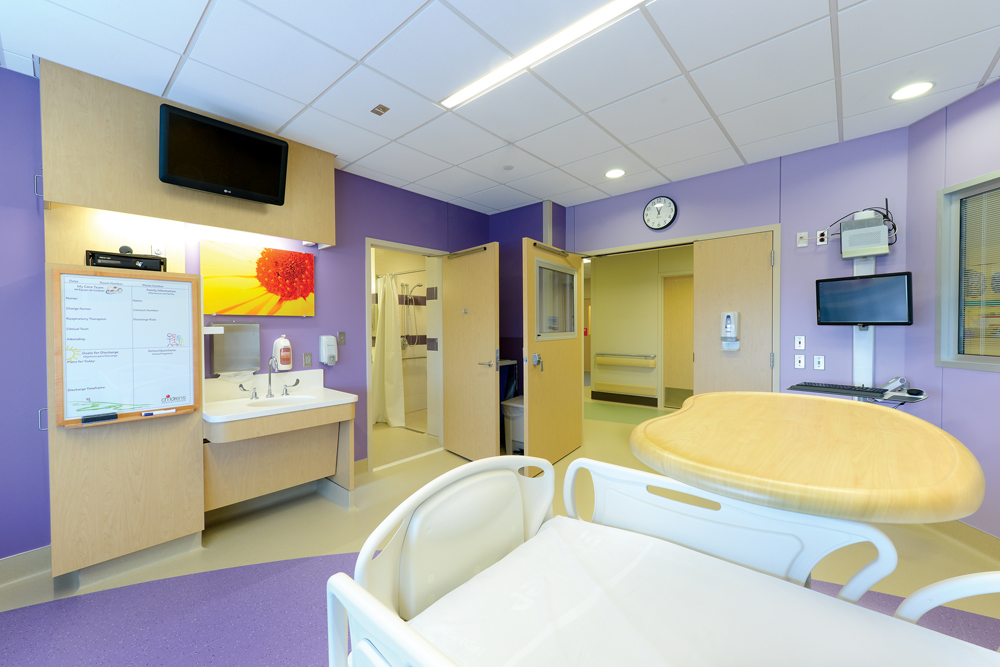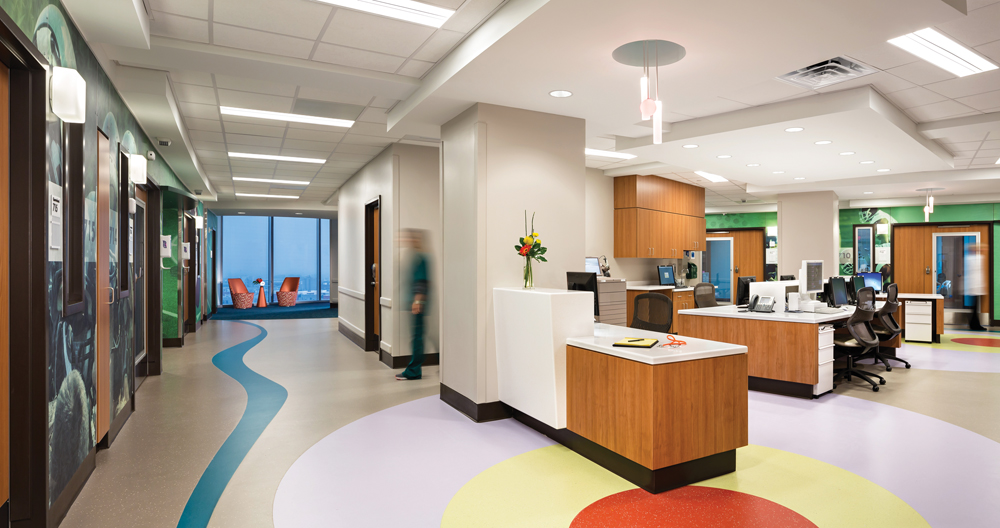Pediatric hospitals face many of the same concerns as their adult counterparts. The most consistent concern is change. Nationally, inpatient bed demand is declining, outpatient visits are soaring, and there is a higher level of focus on prevention and reduced readmissions.
The solution is not as simple as swapping inpatient space with outpatient care to meet the shifting demand. Many facilities have been operating 40% or more of their beds as semiprivates and—driven by reimbursement incentives for patient satisfaction and consumers’ penchant for choosing care based on public performance scores—hospital owners have no choice but to invest their limited capital dollars in new or renovated space to achieve 100% private-bed models.
In certificate of need (CON) states, owners are reluctant to reduce total bed counts due to the uncertainty in future bed demand. To effectively operate within this changing environment, owners look to the healthcare design and construction industry for creative facility solutions that offer highly flexible environments that promote healing.
Flexible Spaces, for Toddlers and Teens
Flexibility is key in helping owners address rapidly changing demands. While this is also true in adult care, children’s hospitals face a greater challenge due to the drastic difference in their patient dynamic. Caring for a patient in the NICU is significantly different than caring for a 16-year-old. Add the fact that pediatric inpatient volumes are sporadic at best, and you have an operational challenge in achieving ideal staff-to-patient ratios.
Children’s Medical Center Dallas has addressed uncertainty by designing patient rooms with a universal care model so they can be converted to ICU rooms with no construction impact. This will allow the hospital to flex with future trends.
Another way pediatric facilities are creating greater flexibility is by developing inpatient units that are more appropriate for all ages instead of just focusing on babies. In doing this, not only does the physical environment need to be highly adaptable to accommodate pediatric patients—i.e., adjustable sink heights, grab bars, and so on—but the design aesthetic must also evolve. Interiors need to move away from cutesy baby motifs to ones more appropriate for a wider age spectrum, from toddlers to teens.
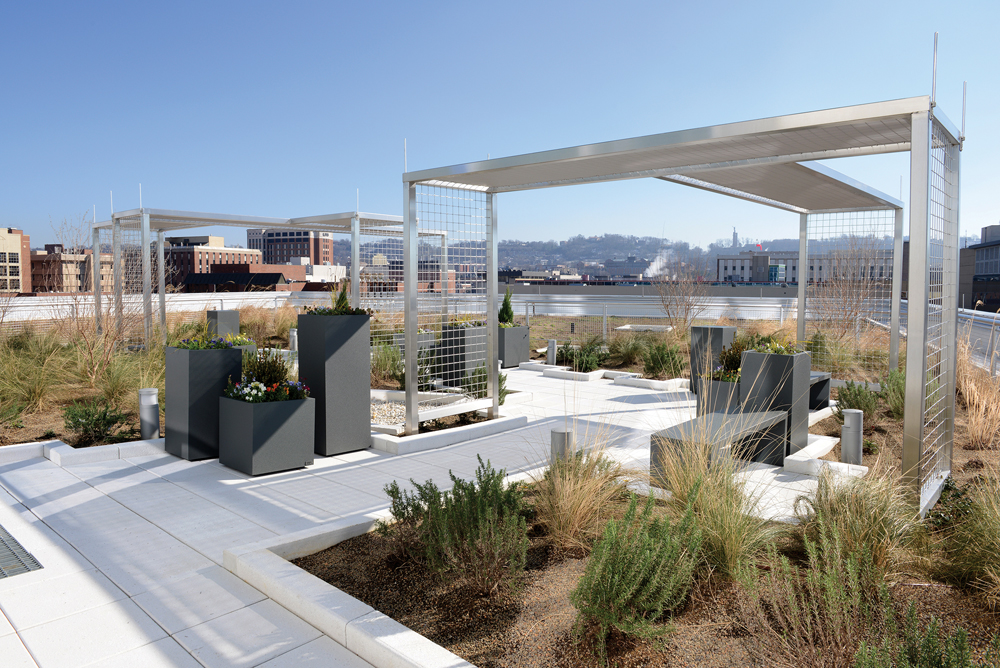
The rooftop garden provides a healing respite in an urban setting and is part of the LEED Gold-certified Benjamin Russell Hospital for Children’s environmentally friendly design.
Children’s of Alabama (COA) in Birmingham, Ala., was faced with these issues before opening its new facility, the Benjamin Russell Hospital for Children, in August 2013. To address these concerns, significant time was spent planning the design and “theme” for each floor. Wall surrounds and digital graphics portray wildlife, sports, nature, transportation, and other easy-to-remember themes. These were carried out in the hallways, common areas, and patient rooms. This strategy not only created a more inviting and comforting space for patients of all ages but also helped in the hospital’s wayfinding efforts. While a parent or child may not remember their room number, they would remember that they are in the “sports” tower, on the baseball floor, with a glove and ball by their room.
Tailoring the Healing Environment
Pediatric hospitals are not alone in their journey to becoming more patient-centered and family-focused, but the creative environments found in today’s children’s facilities puts them light years ahead of their adult-hospital peers. By engaging patients and their families in the design process, leaders are identifying what is most important for comfort and satisfaction.
Customization is increasingly popular. For example, integrating LED lights can enable patients to select their own wall and ceiling colors, giving them ultimate control over the look of their rooms. To further accommodate a broad age span, each patient room at COA is outfitted with an Xbox game console. These systems are tied into the hospital’s Patient Entertainment and Information System to provide an added layer of comfort. Patients, and more importantly their parents, are able to use the systems to research an illness, identify hospital services, and communicate with staff. One patient even commented, “Honestly, the hospital felt more like a hotel than a hospital.”
For larger pediatric units, playrooms for toddlers and teen rooms equipped with Wii stations offer on-unit destinations that allow patients a respite, inviting them to explore and to meet other children. Rooftop gardens are becoming more popular, making a bit of the outdoors accessible. COA’s rooftop garden, near the NICU, is designed to be a healing garden. The Building Team situated the “Quarterback” (West) Tower so that the end caps on each floor overlook Regions Field, home of the Birmingham Barons baseball team. On Friday nights, children can congregate at the end of the hall or in the garden to enjoy the weekly fireworks display.
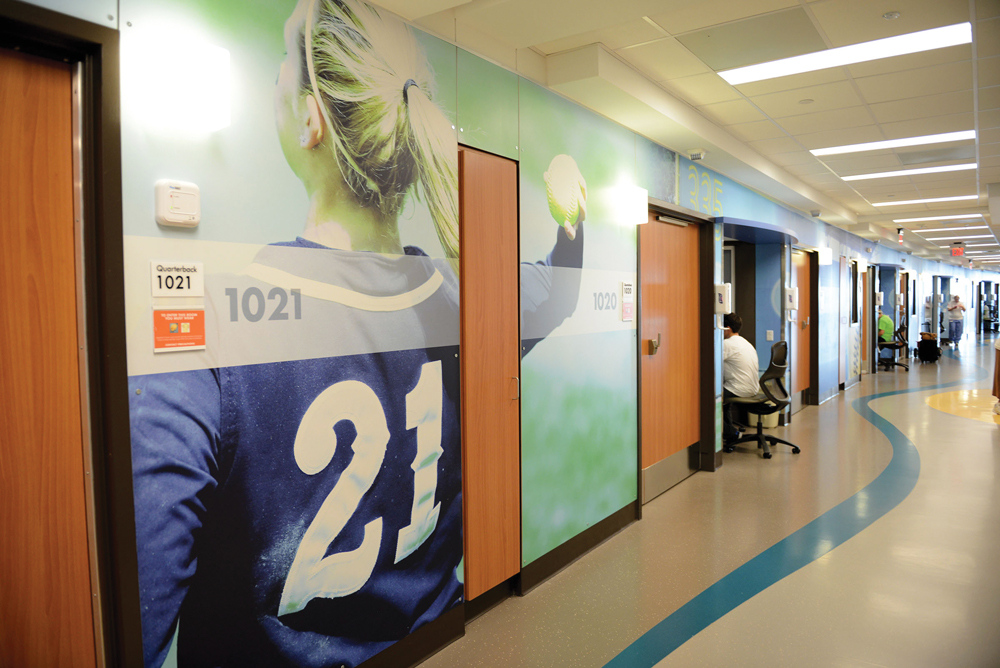
Family friendly themed wall-surrounds, vibrant colors, and a bold room numbering system combine with a wavy “blue river” pattern in the flooring at the Benjamin Russell Hospital for Children help patients and families with wayfinding.
Dedicated family space has also become very popular for children’s hospitals. “Family” zones, in patient rooms and in common areas, are designed to keep family members closer to their children, allowing for some privacy and comfort. The concept focuses on the family’s interaction with the hospital staff and their child to ensure a desirable flow. At design meetings, nursing staff often stress the importance of having a specific zone to accommodate parents within the patient room. In some instances, patient floors have been fitted with a family waiting area equipped with a kitchenette. This feature allows families to feel more at home during lengthy stays by giving them access to a refrigerator, sink, and microwave. Guest laundry areas may also be located on the unit for parent use.
Staff Space: Allow for Decompression
The distinctiveness of a children’s hospital transcends facility design. Staff play a critical role in the care and comfort of the children and their families. Staff often use the term “frequent flyers” to describe parents and children who must come to the hospital regularly for care. Even the security officers stationed at the door become very involved in the lives of these families and children. Staff at all levels, not just the caregivers, get to know the families and will go the extra mile to make their experience as pleasant and stress-free as possible.
Because the work is demanding, Building Teams should give special attention to the caregiver and staff areas of a pediatric facility. Make opportunities for staff to be “offstage” by providing inviting break areas, dining facilities, and outdoor spaces. These features enable staff to decompress during their workday, resulting in improved clinical performance when staff members are “onstage” caring for kids.
Hospitals are not typically envisioned as warm and inviting places. However, changes in design and care standards are creating spaces that provide patients and their families with much more comfort. From the outside “curb appeal” to the internal operations and systems, children’s hospitals are striving to achieve low-stress environments that aid in the healing and wellness of our smallest patients.
Staff spaces are open and comfortable, providing easy access to patient rooms. Glass end caps and sub-waiting areas at the end of each hallway provide expansive views of the city and Birmingham’s Regions Field at Children’s of Alabama.
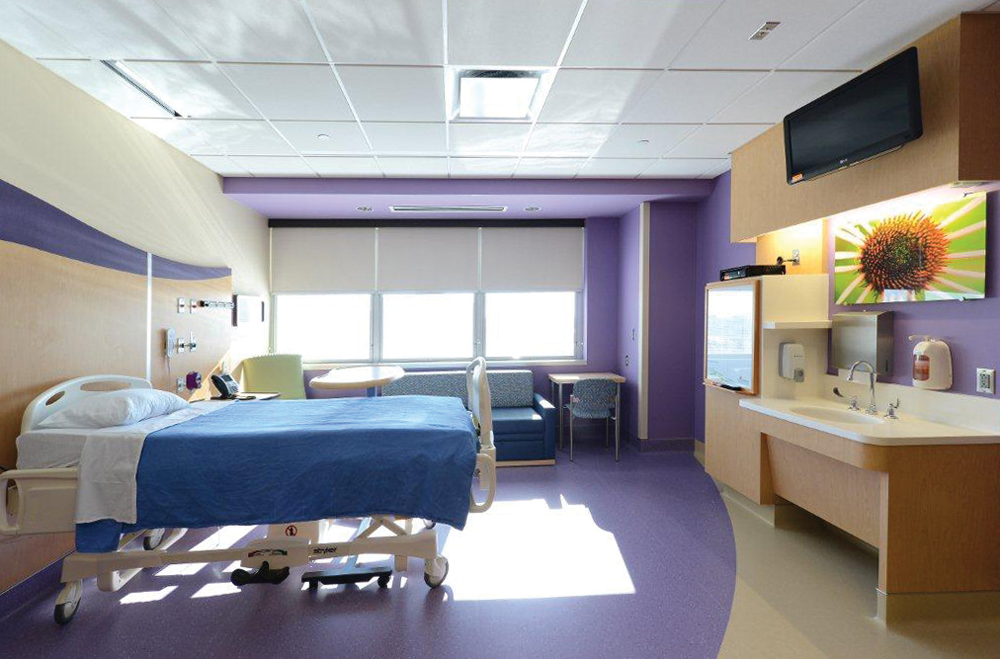
Spacious accommodations, warm aesthetics, and stimulating amenities aim to promote a relaxing environment for patients and their families throughout the healing process at Children’s Medical Center.
ABOUT THE AUTHORS
The authors of this article are affiliated with healthcare consulting firm CBRE Healthcare, based in Richmond, Va. They are Lora Schwartz, AIA, LEED AP, Principal; Stephen Powell, Consultant; Brad Durham, MBA, Principal; Magnus Nilsson, RA, Senior Consultant; Steven Donnelly, Vice President; and Curtis Skolnick, MHA, Vice President.
Related Stories
Sports and Recreational Facilities | Mar 14, 2024
First-of-its-kind sports and rehabilitation clinic combines training gym and healing spa
Parker Performance Institute in Frisco, Texas, is billed as a first-of-its-kind sports and rehabilitation clinic where students, specialized clinicians, and chiropractic professionals apply neuroscience to physical rehabilitation.
Market Data | Mar 14, 2024
Download BD+C's March 2024 Market Intelligence Report
U.S. construction spending on buildings-related work rose 1.4% in January, but project teams continue to face headwinds related to inflation, interest rates, and supply chain issues, according to Building Design+Construction's March 2024 Market Intelligence Report (free PDF download).
Apartments | Mar 13, 2024
A landscaped canyon runs through this luxury apartment development in Denver
Set to open in April, One River North is a 16-story, 187-unit luxury apartment building with private, open-air terraces located in Denver’s RiNo arts district. Biophilic design plays a central role throughout the building, allowing residents to connect with nature and providing a distinctive living experience.
Sustainability | Mar 13, 2024
Trends to watch shaping the future of ESG
Gensler’s Climate Action & Sustainability Services Leaders Anthony Brower, Juliette Morgan, and Kirsten Ritchie discuss trends shaping the future of environmental, social, and governance (ESG).
Affordable Housing | Mar 12, 2024
An all-electric affordable housing project in Southern California offers 48 apartments plus community spaces
In Santa Monica, Calif., Brunson Terrace is an all-electric, 100% affordable housing project that’s over eight times more energy efficient than similar buildings, according to architect Brooks + Scarpa. Located across the street from Santa Monica College, the net zero building has been certified LEED Platinum.
Museums | Mar 11, 2024
Nebraska’s Joslyn Art Museum to reopen this summer with new Snøhetta-designed pavilion
In Omaha, Neb., the Joslyn Art Museum, which displays art from ancient times to the present, has announced it will reopen on September 10, following the completion of its new 42,000-sf Rhonda & Howard Hawks Pavilion. Designed in collaboration with Snøhetta and Alley Poyner Macchietto Architecture, the Hawks Pavilion is part of a museum overhaul that will expand the gallery space by more than 40%.
Affordable Housing | Mar 11, 2024
Los Angeles’s streamlined approval policies leading to boom in affordable housing plans
Since December 2022, Los Angeles’s planning department has received plans for more than 13,770 affordable units. The number of units put in the approval pipeline in roughly one year is just below the total number of affordable units approved in Los Angeles in 2020, 2021, and 2022 combined.
BIM and Information Technology | Mar 11, 2024
BIM at LOD400: Why Level of Development 400 matters for design and virtual construction
As construction projects grow more complex, producing a building information model at Level of Development 400 (LOD400) can accelerate schedules, increase savings, and reduce risk, writes Stephen E. Blumenbaum, PE, SE, Walter P Moore's Director of Construction Engineering.
AEC Tech | Mar 9, 2024
9 steps for implementing digital transformation in your AEC business
Regardless of a businesses size and type, digital solutions like workflow automation software, AI-based analytics, and integrations can significantly enhance efficiency, productivity, and competitiveness.
Office Buildings | Mar 8, 2024
Conference room design for the hybrid era
Sam Griesgraber, Senior Interior Designer, BWBR, shares considerations for conference room design in the era of hybrid work.


